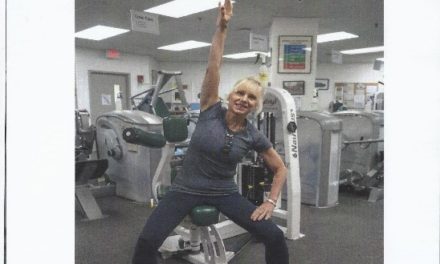By Rita La Rosa Loud, B.S.
“Not enough time,” is why many older adults maintain they cannot fit exercise into their daily routine. “When I retire, there will be ample time to join a fitness program.” Screech! The brakes engage, and the opposite transpires. Retirees are busier than ever, willingly filling precious time, childminding, helping elderly neighbors, driving family members back and forth to appointments, or working part-time to fund mini-trips—leaving behind the most critical piece—taking care of their own physical wellbeing.
With a little planning, strength gains can occur in just 2-3 days per week, 20-30 minutes a session. Clearly, to live a better quality of life, strength training, accompanied by other key fitness factors, should be a number one priority.
WHY STRENGTH TRAIN
The foremost purpose of strength exercise is to improve muscle function. Strength workouts enhance the musculoskeletal system, develop strong bones, tendons, and ligaments, improve body composition (muscle/fat ratio), and increase resting metabolism. It minimizes the risk of back pain and discomfort, serious illnesses and conditions: arthritis, fibromyalgia, diabetes, heart disease, and stroke, as well as degenerative complications such as osteoporosis.
Based on years of research, consistent with the American College of Sports Medicine exercise guidelines, Dr. Wayne Westcott designed time-efficient group fitness programs making exercise desirable to seniors in need of the changes that occur to human musculature and strength.
MODEL STRENGTH PROGRAM
In a study by Westcott, and Guy, 1996, 1,132 young, middle-aged, older adults engaged in 24 minutes of strength training on 12 Nautilus machines, and 24 minutes of endurance training on cardiovascular equipment. After just eight weeks, subjects increased muscle strength by an impressive 40 percent! Also, participants made improvement in body composition, adding 2.5 lbs. of muscle, losing 4.5 lbs. of fat, indicating that basic and brief, relatively time-efficient strength workouts are highly effective, especially compared to other training approaches.
BASIC TRAINING GUIDELINES
• Perform 1 set of each exercise using weight load lifted between 8-12 repetitions.
• Perform each repetition at moderate speed (6 seconds) through full range movement.
Slow training increases strength building stimulus and reduces injury risk.
• Increase weight load by 5 percent once 12 repetitions are completed in proper form.
Progressive resistance is key to continued strength development.
• Train two or three days per week or every other day.
Studies have shown about 90 percent benefit from 2 days/week as much as those who train 3 days/week.
• Perform 20-second static stretch between exercises on Nautilus machines.
Adding stretches amid machines enhances joint flexibility and strength development.
Another key factor to maintaining physical fitness is consistency. With just two regular strength workouts, two (or three) non-consecutive days/week, seniors can improve muscle function, develop stronger bones, tendons, and ligaments, perform better in physical activities, reduce risk of joint/back pain, illnesses/degenerative issues, improve body composition, and increase metabolism, with marginal time commitment.
Retired and ready to carve out some time to maintain strength training as part of an overall exercise program? Schedule a tour or free session at Wayne Westcott, Ph.D. Center for Health and Fitness, Quincy College, President’s Place, 1250 Hancock Street, across from Quincy T. Call Rita 617.405.5978. Free 1-2-hour parking is available (Hancock, Washington, Coddington Streets); parking garage is next to the building for a nominal fee.
Rita La Rosa Loud holds a B.S. in Exercise Physiology with additional education in Sports Medicine and Athletic Training. She is NASM Certified and has been actively involved in the fitness industry for over 35 years. An author, she writes fitness-related articles for various publications. Rita is a Fitness Researcher and Directs Wayne Westcott, Ph.D. Center for Health and Fitness, Quincy College. She can be reached at 617.405.5978, and is available for speaking engagements.



